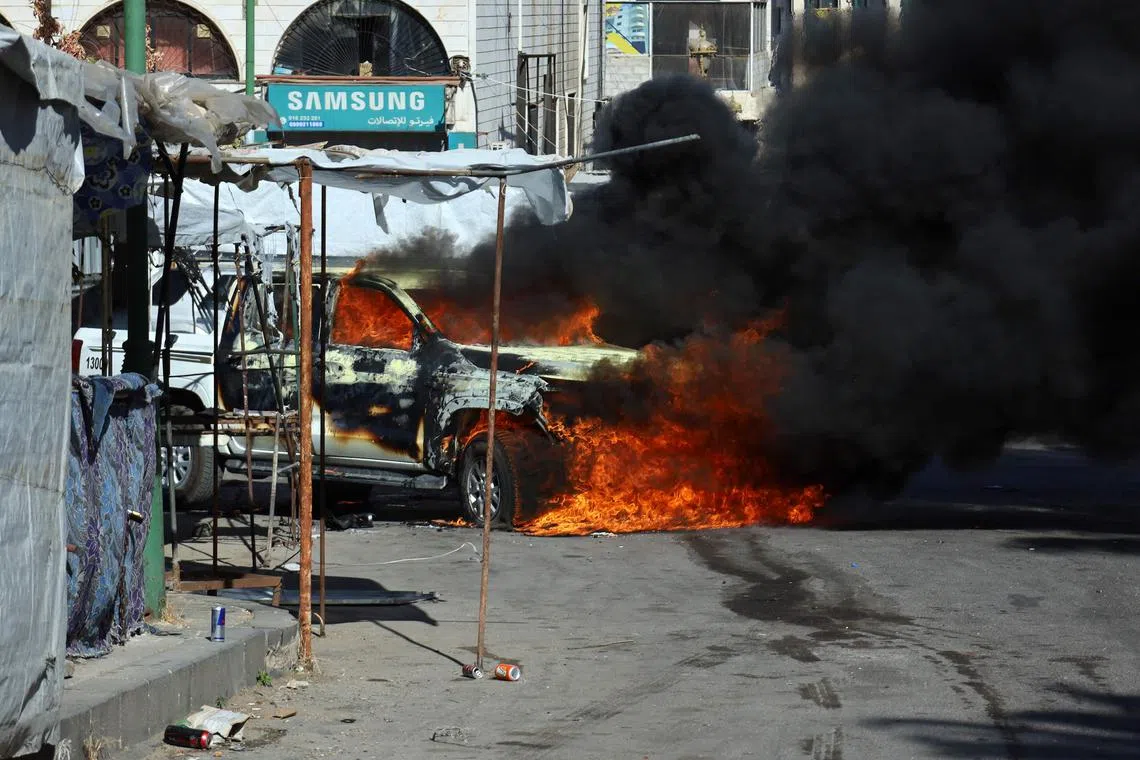After days of bloodshed, residents of Syria’s Druze-majority Sweida confront devastation
Sign up now: Get ST's newsletters delivered to your inbox

Syrian Druze fighters celebrating on top of a damaged army vehicle, after Syrian forces withdrew from Sweida, on July 17.
PHOTO: AFP
Follow topic:
- Sweida faced devastation after government forces withdrew on July 17, leaving looted shops and bodies in the streets. Doctor Hanadi Obeid described it as a "natural disaster".
- Clashes between Druze fighters and Bedouin tribes escalated after government forces intervened, resulting in over 500 deaths, according to the Syrian Observatory for Human Rights.
- Sweida's central hospital was overwhelmed, lacking capacity and supplies. Rayan Maarouf stated, "There is a humanitarian catastrophe in Sweida," with water and electricity cut off.
AI generated
SWEIDA, Syria - Residents emerged from their homes to scenes of devastation on July 17 after government forces withdrew from the Syrian Druze-majority city of Sweida, leaving behind looted shops, burned homes and bodies littering the streets after days of violence.
“What I saw of the city looked as if it had just emerged from a flood or a natural disaster,” 39-year-old Hanadi Obeid, a doctor, told AFP.
What started as deadly clashes between local Druze fighters and Bedouin tribes on July 13 quickly escalated after government forces were deployed to the province the following day.
After reaching an agreement with Sweida’s community leaders, Syrian troops withdrew
“Three bodies were lying in the street, one of them an elderly woman,” Dr Obeid said, adding that she saw “burned cars everywhere, others upside down, and a charred tank”.
Many residents had holed up in their homes as they waited for the fighting to end.
On July 17, Sweida’s typically bustling streets and markets were still largely quiet, with Dr Obeid saying a foul odour emanated from the area as stray dogs roamed around.
As a doctor, she has seen “many corpses and dead bodies, but death has had a different taste in recent days, and I’ve felt it closer to me than ever before”.
Dr Obeid, who has a young daughter, said she feared what awaited her when she returned to work at the city’s main hospital.
More than 500 people from all sides were killed in the violence, according to the Britain-based war monitor the Syrian Observatory for Human Rights.
‘Humanitarian catastrophe’
An AFP photographer reported chaos outside the central hospital, with dozens of bodies brought there since the morning of July 17 after being collected from homes and streets. The photographer counted 15 bodies in the city centre.
Grief-stricken families were seen arriving at the hospital searching for their loved ones.
Local media outlet Suwayda 24 reported that the central hospital was put out of service on July 16 after government forces entered it and clashed with Druze fighters.
A video that circulated on July 16 showed bodies piled up in the morgue, with the refrigerated storage units for remains reaching capacity.
Other videos showed wounded people in the corridors, some on beds and others lying on the floor, and medical staff unable to respond to emergency cases.

A vehicle burning in a street after Syrian government forces pulled out of Sweida, on July 17.
PHOTO: AFP
Mr Rayan Maarouf, editor-in-chief of Suwayda 24, told AFP that more than 150 bodies had been counted at the hospital, which was no longer able to receive corpses.
“The dialysis machines are out of service, and patients are not receiving treatment. There is a humanitarian catastrophe in Sweida,” he said.
Water and electricity services remained cut off in the city, and most shops have closed their doors pending the completion of search operations by local fighters securing the area.
The AFP photographer saw damaged storefronts, their glass shattered in the streets, and others looted. A woman was inspecting her shop, the only one around that had been burned.
Government forces were accused by witnesses, Druze factions and the Observatory of siding with Bedouin tribes and committing abuses, including summary executions.

A Syrian Druze woman, who crossed to the village Majdal Shams in the Israel-annexed Golan Heights the day before, waving as she makes her way back to neighbouring Syria, on July 17.
PHOTO: AFP
As government forces withdrew on July 17, an AFP correspondent in Sweida province saw Bedouin families dismantling their tents before leaving the area, fearing reprisals.
“We have been at war for four days. We want to survive,” said Ms Wadha al-Awad, 58, accompanied by her family.
“We fled and are heading west with our children to Daraa,” she added.
“This is our destiny. We are afraid, and all we want is peace.” AFP

